Research Topics
Conveyor Chains made of Plastic
Continuously working conveyors with 3D-plastic-chains - especially plastic slide chains (flat top and multiflex chains) and modular belts - are being used more and more to transport goods.
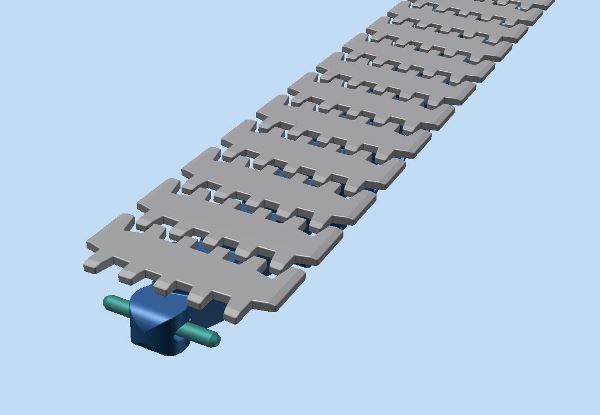
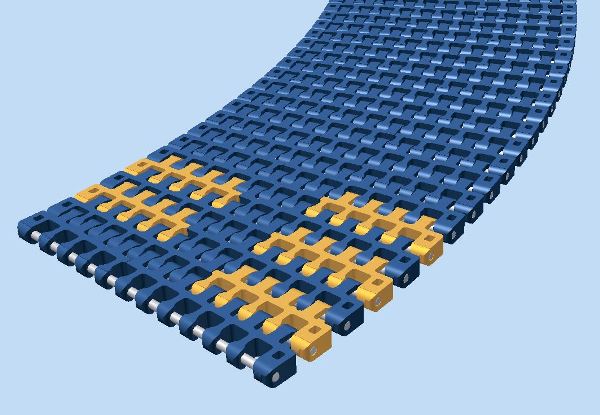
The plastic parts the chains can be produced in large amounts and complex geometries using injection moulding. They are less dense than steel, show good noise-absorbing behaviour and a high corrosion resistance. Plastics have good availability and their properties can be modified depending on their usage). Some of them show excellent sliding properties so that conveyor systems made of it do not have to be lubricated additionally. This is very important for a lot of industrial applications.
On the other hand, plastic chains have lower strength (tensile strength, fatigue strength), lower stiffness (high elongation) and a less thermal stability. That is why long conveying tracks have to be divided - this means additional drives and elaborated transfer points have to be used.
Thermoplastics such as POM, PA, PE or PP are used for chains, slide rails and additional elements. The plastics can be modified to be used for the different cases and loads.
Slide Chains
Slide chain conveyors are mostly used in single-train transport systems for light goods (up to 20 kg) and medium velocities (up to 1m/s). Often, the guidance system is of modular design. Even very complex conveyor layouts can be assembled of straights, horizontal and vertical curves, drive and idler units as well as frame components.
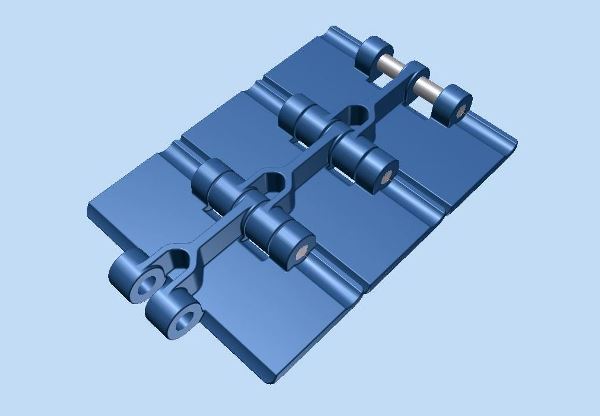
straight-running
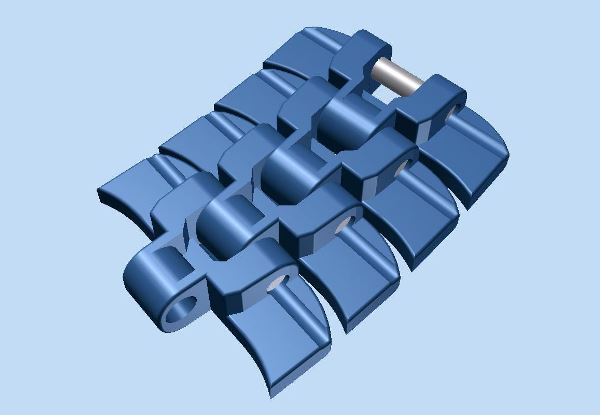
sideflexing

sideflexing
Generally there are two different types of slide chains. The one-piece flat top chains which are flexibly connected with a steel bolt. Due to the joint clearance, their curve properties can reach the minimum radius of 500 mm. Flat top chains are made of stainless steel or plastic. Multi flex chains (also 3D-slide chains) have an additional pin as a second horizontal joint which enables minimum radii of 150 mm as well as higher chain tension.
Slide chain conveyors are used in many areas. Their lubrication-free operation enables the application in various industries, e.g., food, packaging, electronics and pharmaceuticals. The resistance against different chemicals as well as wear resistance makes their application in linking facilities, machined production and assembly lines possible.
Modular Belts
Modular belts consist of plastic modules, which are flexibly connected with steel or plastic bolts. These modules can also be placed parallel, so that widths up to 45 m are possible. The material and design of these chains are adapted to user requirements and are therefore very diverse. There are modular belts of different size, straight running and side flexing, with closed, half-open or structured surface.
Modular belts are not only used for transportation but they also allow processes like washing, drying etc., during the transportation. Modular belts are often used in the food industry (light goods) as well as in the paper processing industry, in distribution centers, baggage transportation but also for heavy duty applications in the engineering and automotive industry.
On straight conveyor tracks, modular belts can withstand high tensile forces. However, main problems occur in horizontal curves, because of the radial supporting forces, which lead to high friction losses. Additionally, the tensile forces are located in the outer side of the chain, which limits the conveyor design possiblities and leads to serious wear or even breaks of the chain.
Research Focus
The professorship Material Handling and Conveying Engineering has a long tradition of collaborating with different companies from the chain and conveyor industry. Development of plastic conveyor chains and complex conveyor systems has been the focus of their cooperation. This includes the development of chains and systems, material choice, production, mechanical and tribological analysis, up to dimensioning basics. The key aim is to increase conveyor process efficiency, that is, increase capacity and flexibility and decrease the input (electrical power). The main foci of our research activities are:
- Improvement of chain's mechanical properties, especially fatigue strength and stiffness by improving design, materials and production processes
- Minimization of friction and wear of typical slide-pairings, especially between chain and slide rail to reduce tensile force and power transmission (see research focus of tribology)
- Replacement of sliding friction by rolling friction (see project Rolling Conveyor Engineering)
- Fundamental research regarding chain's power and motion behavior (forces within chain links or within the system, vibration and noise analysis etc.)
- Materials and design requirements for special applications, such as electrostatic charge or the transportation of food, chemicals, etc.
- Development of test methods to determine dimensioninig parameters
- Development of computational and dimensioning basics for chains and conveyor systems
Conveyor Chains made of Steel
Plastic conveyor chains are increasingly found at the conveyor market. However, for the time being they are no alternative to the use of steel chains. Steel conveyor chains are mainly used under rough load and operating conditions or for aggressive conveyor goods. They are also used in accumulation and load chain conveyors. Despite their small size they are able to transmit relatively large forces in a safe way and even synchronously. For these applications, the mechanical and thermal structure of platics is not suitable.
Generally steel chains have to be lubricated, which on the one hand limits their field of application due to contaminations. On the other hand, they have to be maintained regularly. One aim ist the improvement of the lubrication effect, which is to achieve by using special materials and lubrication oils or by constructive measures, so that lubrication oil permanently stays at the joints of the chain. This also leads to decreasing wear and to increasing maintenance intervals.
Research Focus
The examination of lubricants for steel link chains regarding their functionality and lifetime and the development of methods for monitoring their functionalities (e.g. request for relubrication or for replacement of chain) are part of our research work. Furthermore, contact surfaces between chain and good or rather between chain and guide rails (often made of plastic) are subject to examiniation.
- Analysis and dimensioning of accumulation conveyor systems or rather their chains
- Monitoring systems for conveyor chains
- Examination of lubricants for steel link chains
- Examiniation of wear and friction between steel chains and goods or between steel chains and guide rails
- Examniation of steel chains with plastic elements
- Dimensioning of conveyor chains
- Examination of breaking and fatigue strength
Transport Toothed Belts
In conveyor technology, toothed belts are used for transportation (goods are directly placed on the belt), or implicit in linear drives, such as lift equipment in automated hoisting and retrieval systems. Compared to drive toothed belts, their velocities are lower and their dimensions (profile geometry and width of belts) are bigger.
Their main advantage is the form-locking drive. The torque can be transmitted without slippent and therefore, a synchronal movement of more than one parallel running way is possible. That is why they are also called synchronous belts. They are made of thermoplastic polyurethane, so that they can be continously produced and connected in every length. They can easily be enhanced, for example by attaching additional elements (e. g. carriages, fixing elements) or back coatings (adaption at the good) or by specific treatments of the belt. At the toothing side, these belts are often coated with special textures to reduce friction between them and the guide rails or in the area of toothed locker.
Research Focus
The focus of research in this area is the reduction of the movement resistance between the toothed belt and the support rail, which frequently leads to a high driving power as well as temperature-induced wear phenomena. In addition, solutions for the functionalization of toothed belts, e. g. the integration of line carriers for energy and data transmission, connection technologies as well as conveying technology applications of all kinds are investigated and dimensioning bases for toothed belt conveyors are produced.
- Friction and wear characteristics of toothed belts and guide rails
- Integration of line carriers and non-contact energy and data transmission
- Examination of transport toothed belts and conveyor systems
- Analysis of toothed belt connections
- Dimensioning of toothed belt conveyors
 |
Handout english |
Drive Toothed Belts and Pretensioning
Drive toothed belts can be found in mostly fast-running gear units and are used for speed and torque transmission, which can be performed with high efficiency and extremely precise due to the slip-free operation.
Toothed belts must always be prestressed, whereby the magnitude of the prestressing force has a decisive influence on the function and service life of the entire transmission. Excessive pretensioning can lead to strong belt vibrations or teeth skipping on the toothed pulleys. Too high loads cause a strong load on the bearings and the belt and thus adversely affect the wear and durability of the gearbox components.
The conventional methods for applying the prestressing force on the one hand usses the elasticity of the toothed belt and the gear by changing the axial distance of the toothed pulleys or an additional, fixed tensioning roller. Furthermore, complex clamping systems are applied which apply the clamping force by means of springs and often contain additional damping elements.
A third method, developed together with an industrial partner at the Professorship of Conveying Technology, uses an elastic, annular clamping and damping element, which is used to save space between the belt branches. Due to the special clamping characteristics of this element, the gear unit is almost completely relieved when the motor is at a standstill. In the operating state the pretensioning force automatically adapts to the acting torque. The tensioning element works independent of the direction of rotation, compensates for axial distance or concentricity errors and effectively dampens torque shocks and belt vibrations.
Setting the center distance
Tensioning and damping element
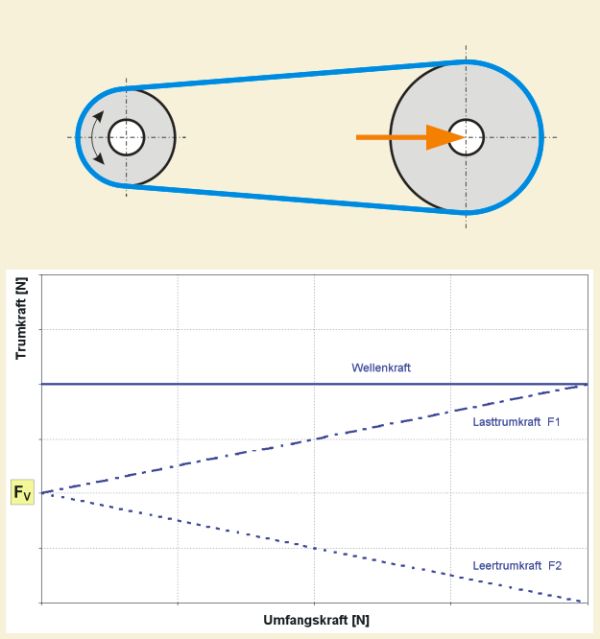

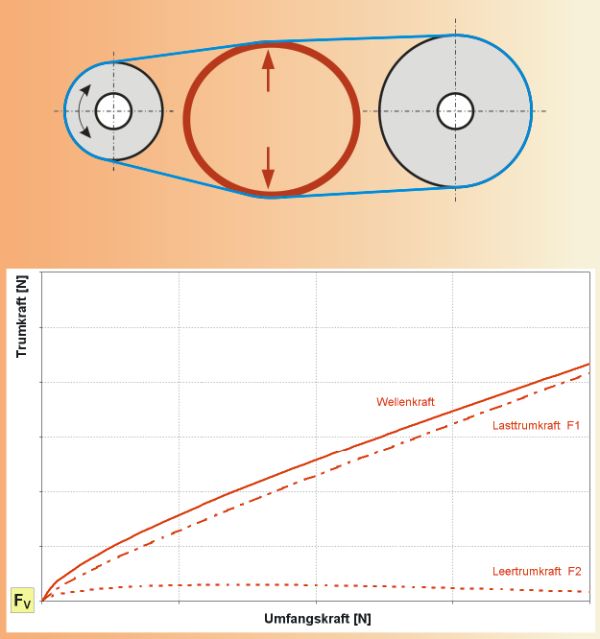
- No additional elements required
- Reversibility
- Very sensitive to dimensional tolerances (exact force adjustment difficult)
- Danger of malfunction or overtension
- High preload in the rest condition necessary
- No vibration damping
- Relatively low prestressing force
- Integration of vibration dampers possible
- Complex additional component
- External mounting base required (space requirement)
- Not reversible
- Simple, space-saving assembly
- Almost complete gear relief in the installed state
- Automatic clamping force adjustment to the load
- Reversibility
- Efficient damping of belt and torsional vibrations
- Low rotation angle difference between input and output
Research Focus
For many years now, the Professorship of Conveying Technology has dealt with the investigation of alternative clamping methods for toothed belt transmissions. With the development of the annular tensioning and damping element, a completely new, drive-friendly tensioning characteristic was developed. The current tasks consist in the derivation of further application fields as well as the development of dynamic calculation models. Further research focuses on, among other things, investigations on the jumping behavior as well as vibration and noise analyzes.
- Clamping systems for toothed belt transmissions, in particular annular tensioning and damping element "roll ring" (Ebert Kettenspanntechnik GmbH, Schkeuditz)
- Skipping behavior of toothed belts
- Alternative side guidance of toothed belts
- Vibration and noise analyses
- Analysis and dimensioning of toothed belt drives, efficiency measurements
Importance of Tribology in Conveying
Tribology is the science of friction, wear and lubrication. Plastics are used in nearly every tribological system in conveyor techniques. Alongside many advantages such as low density, very good processability, sound damping etc., the main advantage is that they have excellent sliding properties, so additional lubrication is normally not necessary. This enables application in many areas, even in sensitive sectors like food, pharmaceutical or electronic industry where additional lubrication is not desired.
Significant slide-pairings in continuous conveyors are:
- Traction mechanisms (steel and plastic chains, toothed and modular belts) vs. slide rails (mostly consists of plastic)
- Traction mechanisms vs. conveyor goods (every possible material: metal, plastic, glass, paperboard etc.)
In some materials handling applications e.g., if conveyor goods have to be transported on inclined tracks, a high coefficient of friction (CoF) is required. However, in most technical systems friction is undesirable because it generates heat and wear of traction and / or guide elements, high stress on traction mechanisms as well as high drive power. As a result, friction causes remarkable costs because of drive energy needed, regular maintenance intervals or unscheduled standstills of a conveyor system.
According to a study of the German Society for Tribology [www.gft-ev.de] Germany loses yearly about 35 billion Euros as a consequence of wear and friction. If the best available technology (BAT) in the field of tribology would be implemented in industry, 5 billion Euros could be saved. Research in this field could contribute to further saving potential.
The working group Traction Mechanisms and Tribology of the Chemnitz University of Technology aims at meeting this challenge.
Causes of Friction and Wear
There are two main causes of friction:
- Deformation (plastic deformation of asperities, ploughing) and
- Adhesion (atomic and molecular interactions in the real contact area)
Both phenomena occur at the same time, but vary depending on material and surface properties. CoF of dry running friction pairings with plastic participation strongly depends on stress and environmental conditions. For example, contact pressure (weight of goods), velocity, ambient and contact area temperature etc., which change within the operating time. In spite of alleged equal boundary conditions, in practise CoF increases over time which can result in sudden lack of drive power, strong heating, excessive wear or even complete failure of the system.
Research Approaches to Friction and Wear Reduction
Friction and the wear can be specifically influenced when causes of friction and effects of the surroundings on the tribological system are known. It must be taken into consideration that friction is a system parameter and not a property of the material. Therefore a low-friction material combined with another material could lead to a disadvantageous combination. Furthermore, low friction does not necessarily mean low wear.
Tribological behavior examination focuses mainly on dry friction pairings with the participation of at least one plastic material with reference to conveyor technology. Friction and wear are investigated under different loading and environmental conditions (e.g. in a climate chamber) and the results are registered in a tribological database. Main approaches to reduce friction and wear are:
- Research and modification of polymeric materials
- Research and aimed influencing of surface structures
- Coating of polymeric surfaces
- Examination and modification of textile covered surfaces
- Design measures to reduce friction - e.g. replacement of sliding friction by rolling friction
Different self-developed test benches are available for research. These enable the application of various load conditions to samples as well as their measurement and analysis over long testing periods.

